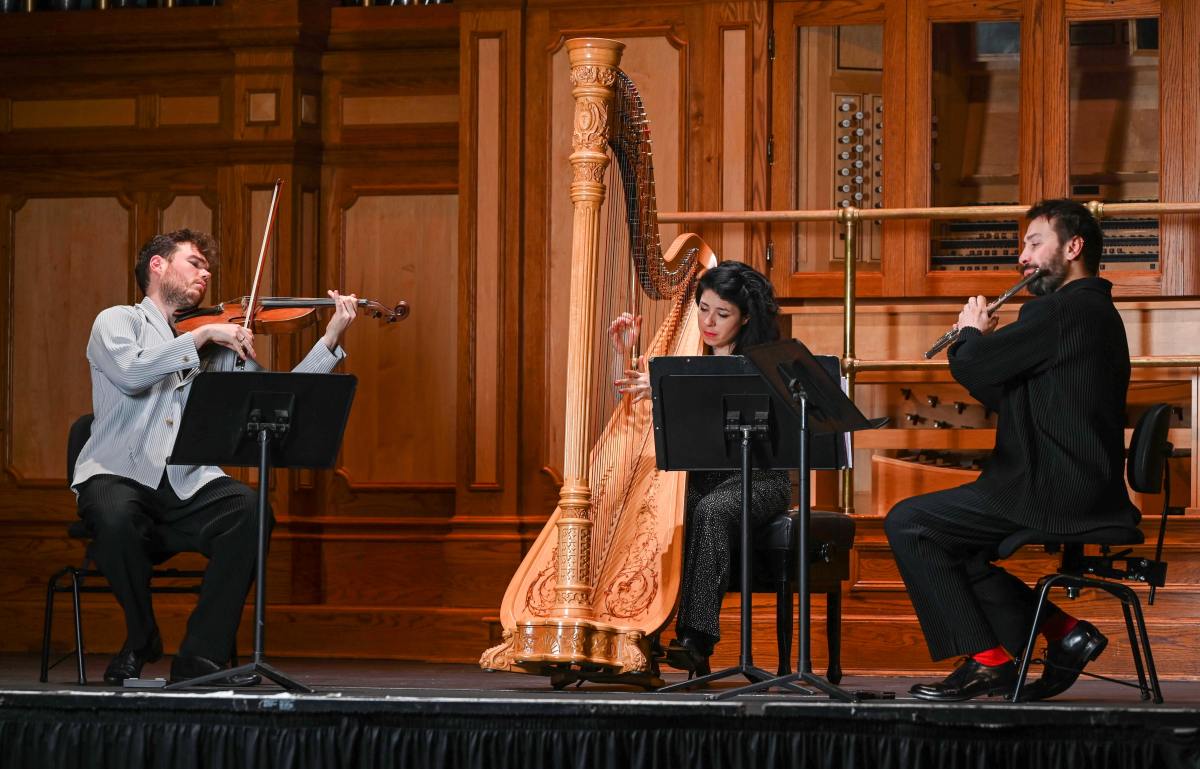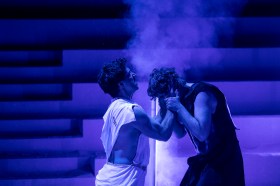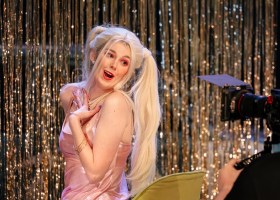The title of the latest Musica Viva tour, Among the Birds and the Trees, depicts the space that Claude Debussy thought he would like to occupy on his death. It is a wonderful image, taken from the last stanza of Paul Verlaine’s poem ‘Clair de Lune’, which Debussy set to music many times. That work figures in the concert program, alongside Debussy’s impressive Sonata for Flute, Viola and Harp and Jardins sous la pluie (Gardens in the rain) from Estampes.
Music has often been used to explore the inner reflective nature of humankind as well as the natural world such as gardens, wind, rain, the sea and birdsong, to name a few – all touched on in this concert program. Indeed, it’s the major theme, which is a salutary reminder of our place in the world of nature, alongside the fragility of our survival.
The concert repertoire is based predominantly on exploring musical development since Debussy at the turn of the 20th century, utilising this rarely heard combination of flute, viola and harp. In Adam Walker (flute), Timothy Ridout (viola) and Anneleen Lenaerts (harp), we hear some of the best exponents of these instruments, all virtuosic performers in their own right with impressive pedigrees.
The program commences with three individual solos, no doubt to show off each musician’s individual credentials, though perhaps a brighter collective work for all three to perform together before moving to solos may have been preferable. The stage is sparse with no decoration, just chairs and music stands and the harp centre stage. This gives it the disconcerting feeling of a high-level audition process.
Walker plays George Benjamin’s Flight, a dramatic and powerful composition, inspired by birds flying across the Alps. Physically demanding to play, the work highlights the extremities and capabilities of the instrument. The atonality of the work denotes clipped bird sounds as they soar, interrupted by silent passages as they dip down, eerily uncomfortable but also mesmerising. Walker’s playing is superlative, but the work may have been better appreciated at a later point in the program.
Lenaerts follows with Debussy’s Jardins sous la pluie for the harp. For this glorious work, originally written for piano, the harp brings out the colours of the composition perfectly. The rain denoted is here perhaps more delicate and quieter, and it is beautifully played. Lenaerts has another solo later in the program, Debussy’s Clair de Lune, also transcribed for harp from the piano. This ravishing work, so well-beloved, is exquisitely managed by Lenaerts, each note caressed with love and care to give it an ethereal sensibility that was very well-received in the performance attended by this reviewer.
Ridout’s solo work is Telemann’s Fantasia No.7 in E-flat major, a piece originally written for violin. In four separate short movements, entitled Dolce, Allegro, Largo and Presto, the rich darkness of the lower notes of Ridout’s instrument inject each movement with well-placed emotions and dynamics. It is technically superb and extremely well-played, with an ease that belies his obvious skills.
The last work before the interval, and for all three players, is Gubaidulina’s The Garden of Joy and Sorrow, inspired by the poems of both the German writer, Francisco Tanzer, and Armenian poet, Sayat-Nova. Ridout reads both poems before the piece is played. It is a strongly spiritual work, offering an almost hypnotic yet varied sonic palette of sounds from all three players. The harp’s glissandi alongside both the flute and the viola’s high-pitched harmonics seem to suggest birds or insects on the wing. Additionally, some beautiful legato phrases offer contrasting lyricism. It’s a fascinating work that is overwhelmingly sad, crafted exceptionally well by all three players.
Messiaen’s Le Merle noir (the blackbird), originally written for flute and piano, is here transcribed to flute and harp. Messiaen’s unique harmonic and rhythmic language, with a love of including birdsong in his music, has offered Walker the opportunity to deliver the most astonishing rendition of this work as the blackbird. Demanding great prowess technically, Walker gives us the closest thing to a real bird with his trills and full-throated sounds. The rhythm, tempi, harmonics and dynamics are all perfectly realised, while the combination of harp and flute allows the flute to soar across the more delicate sonority of the other instrument. Aurally and visually magical.
Takemitsu’s And then I knew ‘twas Wind was written to be played alongside Debussy’s Sonata for Flute, Viola and Wind and is a perfect accompaniment to that work. A compositionally distinctive work of great beauty and poignancy, it is based on a poem by Emily Dickinson. Depicting a leaf being buffeted in the wind, it links Takemitsu’s preoccupation with the natural world to human experience. Here, the blend of all three instruments works exceptionally well, with mostly lyrical phrasing while the gentle and sad sonority is given the lightest of touches by harp, viola and flute. Musically impressionistic, the piece has a sense of reverie with some of the most exquisite pianissimo in its final notes.
Finally, we arrive at Debussy’s work for the flute, viola and harp around which the concert was conceived. It is so well-composed for these three instruments that it soars off the page with joy and passion, enabled by the virtuosity of the players. A colourful musical soundscape pervades the three movements. Pastorale brings out the sounds of the countryside in all its glory, with much emphasis on Debussy’s impressionistic sonority. Interlude offers speedy tuneful melodies that are thrown back and forth with alacrity between viola and flute. The Finale is fierce and fast, with the delivery of a virtuosic flute.
For the performance ArtsHub attended, an encore was offered and willingly accepted – the second Interlude from Jacques Ibert’s work for flute, violin and clavichord, here transposed to viola and harp. Being based on an Andalusian dance, it was a complete change of mood. It was fiery, with a Spanish gypsy quality and a rolling melody that was infectious and upbeat. A lovely finish to the program.
Read: Music review: London Symphony Orchestra: Adams, Debussy and Ravel, QPAC
Under Paul Kildea’s leadership as Artistic Director, Musica Viva tours artists and programs that are unique to Australia, offering rare combinations such as this. Among the Birds and the Trees presents three extraordinarily talented musicians whose technical skills and exquisite playing offer an exceptionally high-quality of first-rate music making.
Among the Birds and the Trees presented by Musica Viva Australia
Conservatorium Theatre, Griffith University Brisbane
Artists: Adam Walker, Timothy Ridout, Anneleen Lenaerts
Among the Birds and the Trees is touring across Australia until 14 May.






